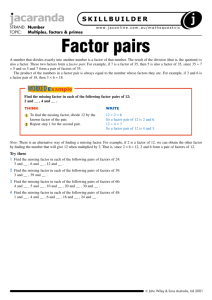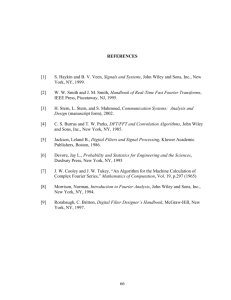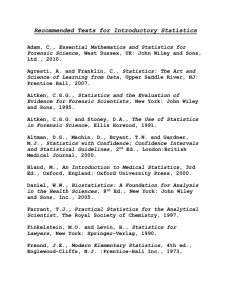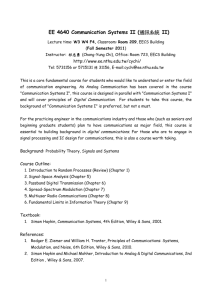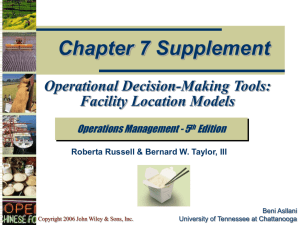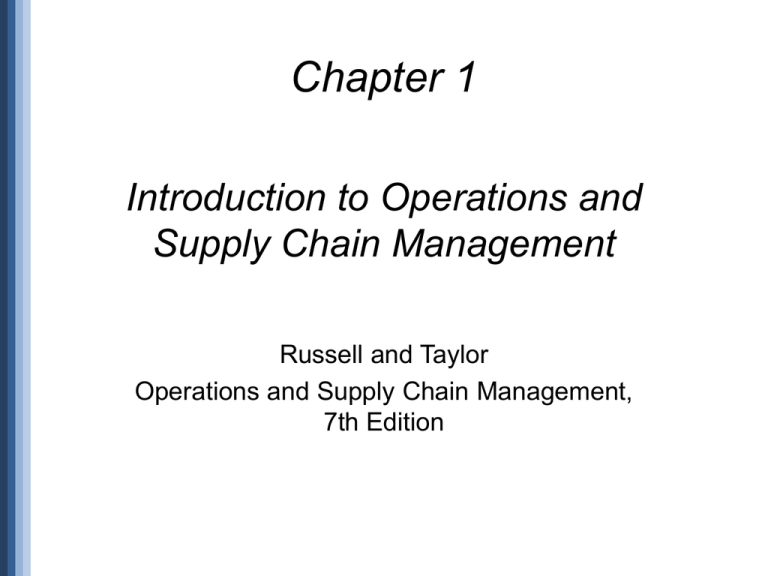
Chapter 1
Introduction to Operations and
Supply Chain Management
Russell and Taylor
Operations and Supply Chain Management,
7th Edition
Lecture Outline
• The Operations Function – Slide 8
• The Evolution of Operations and Supply Chain
Management – Slide 13
• Globalization – Slide 21
• Productivity and Competitiveness – Slide 25
• Strategy and Operations – Slide 30
• Organization of the Text – Slide 45
• Learning Objectives of this Course – Slide 47
© 2014 John Wiley & Sons, Inc. - Russell and Taylor 8e
1-2
Learning Objectives
• Describe what the operations function is and how it
relates to other business functions.
• Discuss the key factors that have contributed to the
evolution of operations and supply chain management.
• Discuss how and why businesses operate globally, and
the importance of globalization in supply chain
management.
• Calculate and interpret productivity measures used for
measuring competitiveness.
• Discuss the importance of operations and supply chain
management to a firm’s strategy, and the process of
developing, aligning and deploying strategy.
© 2014 John Wiley & Sons, Inc. - Russell and Taylor 8e
1-3
Operations Management
• What is Operations Management?
• design, operation, and improvement of productive
systems
• What is Operations?
• a function or system that transforms inputs into
outputs of greater value
• What is a Value Chain?
• a series of activities from supplier to customer that add
value to a product or service
© 2014 John Wiley & Sons, Inc. - Russell and Taylor 8e
1-4
Transformation Process
• A series of activities along a value chain extending from
supplier to customer
• Activities that do not add value are superfluous and
should be eliminated
© 2014 John Wiley & Sons, Inc. - Russell and Taylor 8e
1-5
Transformation Process
• Physical: as in manufacturing operations
• Locational: as in transportation or warehouse
operations
• Exchange: as in retail operations
• Physiological: as in health care
• Psychological: as in entertainment
• Informational: as in communication
© 2014 John Wiley & Sons, Inc. - Russell and Taylor 8e
1-6
Operations as a
Transformation Process
INPUT
•Material
•Machines
•Labor
•Management
•Capital
TRANSFORMATION
PROCESS
OUTPUT
•Goods
•Services
Feedback & Requirements
© 2014 John Wiley & Sons, Inc. - Russell and Taylor 8e
1-7
The Operations Function
•
•
•
•
•
•
•
•
•
•
Organizing work
Selecting processes
Arranging layouts
Locating facilities
Designing jobs
Measuring performance
Controlling quality
Scheduling work
Managing inventory
Planning production
© 2014 John Wiley & Sons, Inc. - Russell and Taylor 8e
Operations Function
• Operations
• Marketing
• Finance and
Accounting
• Human
Resources
• Suppliers
© 2014 John Wiley & Sons, Inc. - Russell and Taylor 8e
1-9
Sample Organizational Structure
CEO
Chief Executive Officer
CFO
Chief Financial Officer
COO
Chief Operating Officer
CIO
Chief Information Officer
VP Human Resources
VP Operations
VP Supply Chain
Management
VP Marketing
© 2014 John Wiley & Sons, Inc. - Russell and Taylor 8e
C3-10
How is Operations Relevant
to my Major?
• Accounting
• “As an auditor you must understand the
fundamentals of operations
management.”
• Information
Technology
• “IT is a tool, and there’s no better place to
apply it than in operations.”
• Management
• “We use so many things you learn in an
operations class—scheduling, lean
production, theory of constraints, and
tons of quality tools.”
© 2014 John Wiley & Sons, Inc. - Russell and Taylor 8e
1-11
How is Operations Relevant
to my Major?
• Economics
• Marketing
• Finance
• “It’s all about processes. I live by
flowcharts and Pareto analysis.”
• “How can you do a good job marketing a
product if you’re unsure of its quality or
delivery status?”
• “Most of our capital budgeting requests
are from operations, and most of our
cost savings, too.”
© 2014 John Wiley & Sons, Inc. - Russell and Taylor 8e
1-12
Evolution of Operations and Supply
Chain Management
• Craft production
• process of handcrafting products or services for
individual customers
• Division of labor
• dividing a job into a series of small tasks each
performed by a different worker
• Interchangeable parts
• standardization of parts that enabled mass production
• Scientific management
• systematic analysis of work methods
© 2014 John Wiley & Sons, Inc. - Russell and Taylor 8e
1-13
Evolution of Operations and
Supply Chain Management
• Mass production
• high-volume production of a standardized product for
a mass market
• Quality revolution
• an emphasis on quality and the strategic role of
operations
• Lean production
• adaptation of mass production that prizes quality and
flexibility
© 2014 John Wiley & Sons, Inc. - Russell and Taylor 8e
1-14
Historical Events in
Operations Management
Era
Industrial
Revolution
Scientific
Management
Events/Concepts
Dates
Originator
Steam engine
Division of labor
Interchangeable parts
Principles of scientific
management
1769
1776
1790
James Watt
1911
Frederick W. Taylor
Time and motion studies
1911
Activity scheduling chart
Moving assembly line
1912
1913
© 2014 John Wiley & Sons, Inc. - Russell and Taylor 8e
Adam Smith
Eli Whitney
Frank and Lillian
Gilbreth
Henry Gantt
Henry Ford
1-15
Historical Events in
Operations Management
Era
Human
Relations
Operations
Research
Events/Concepts
Dates
Originator
Hawthorne studies
1930
1940s
1950s
1960s
1947
1951
Elton Mayo
Abraham Maslow
Frederick Herzberg
Douglas McGregor
George Dantzig
Remington Rand
1950s
Operations research
groups
1960s,
1970s
Joseph Orlicky, IBM
and others
Motivation theories
Linear programming
Digital computer
Simulation, waiting
line theory, decision
theory, PERT/CPM
MRP, EDI, EFT, CIM
© 2014 John Wiley & Sons, Inc. - Russell and Taylor 8e
1-16
Historical Events in
Operations Management
Era
Events/Concepts
JIT (just-in-time)
TQM (total quality
management)
Strategy and
Quality
Revolution operations
Dates Originator
1970s
1980s
1980s
Reengineering
1990s
Six Sigma
1990s
© 2014 John Wiley & Sons, Inc. - Russell and Taylor 8e
Taiichi Ohno (Toyota)
W. Edwards Deming,
Joseph Juran
Wickham Skinner,
Robert Hayes
Michael Hammer,
James Champy
GE, Motorola
1-17
Historical Events in
Operations Management
Era
Events/Concepts
Internet
Revolution
Internet, WWW, ERP,
1990s
supply chain management
Globalization
Dates Originator
E-commerce
2000s
WTO, European Union,
Global supply chains,
Outsourcing, Service
Science
1990s
2000s
© 2014 John Wiley & Sons, Inc. - Russell and Taylor 8e
ARPANET, Tim
Berners-Lee SAP,
i2 Technologies,
ORACLE, Dell
Amazon, Yahoo,
eBay, Google, and
others
China, India,
Emerging
economies
1-18
Historical Events in
Operations Management
Era
Events/Concepts
Sustainability Global warming
Carbon footprint
Green products
Corporate social
responsibility (CSR)
UN Global Compact
© 2014 John Wiley & Sons, Inc. - Russell and Taylor 8e
Dates Originator
Today
Numerous
companies,
statesmen,
governments,
United Nations,
World Economic
Forum
1-19
Evolution of Operations and Supply
Chain Management
• Supply chain management
– management of the flow of information, products, and services
across a network of customers, enterprises, and supply chain
partners
© 2014 John Wiley & Sons, Inc. - Russell and Taylor 8e
1-20
Globalization
• Why “go global”?
–
–
–
–
–
favorable cost
access to international markets
response to changes in demand
reliable sources of supply
latest trends and technologies
• Increased globalization
– results from the Internet and falling trade barriers
© 2014 John Wiley & Sons, Inc. - Russell and Taylor 8e
1-21
Hourly Compensation
© 2014 John Wiley & Sons, Inc. - Russell and Taylor 8e
1-22
GDP per Capita
1-23
Trade in Goods, % of GDP
Copyright 2014
1-24
GDP
16.00
Figure 1.7 - GDP (in trillions $US)
14.99
14.00
12.00
10.00
8.00
7.32
5.87
6.00
3.60
4.00
2.77
2.48
2.44
2.19
2.00
1.86
1.85
Russian
Federation
India
0.00
U.S.
China
Japan
Germany
© 2014 John Wiley & Sons, Inc. - Russell and Taylor 8e
France
Brazil
U.K.
Italy
1-25
Trade in Goods, % of GDP
Figure 1.8 - Trade in Goods as % of GDP
80.0
70.0
60.0
Brazil
Percent
50.0
China
Germany
40.0
India
Japan
30.0
Mexico
U.S.
20.0
10.0
0.0
2007
2008
© 2014 John Wiley & Sons, Inc. - Russell and Taylor 8e
2009
2010
2011
1-26
Manufacturing Output
$2,500.00
$2,000.00
$1,500.00
China
Germany
Japan
$1,000.00
U.S.
$500.00
$0.00
2004
2005
2006
© 2014 John Wiley & Sons, Inc. - Russell and Taylor 8e
2007
2008
2009
2010
2011
C3-27
Productivity and Competitiveness
• Competitiveness
• degree to which a nation can produce goods and
services that meet the test of international markets
• Productivity
• ratio of output to input
• Output
• sales made, products produced, customers served,
meals delivered, or calls answered
• Input
• labor hours, investment in equipment, material usage,
or square footage
© 2014 John Wiley & Sons, Inc. - Russell and Taylor 8e
1-28
Measures of Productivity
© 2014 John Wiley & Sons, Inc. - Russell and Taylor 8e
1-29
Osborne Industries
B5*B7
B6*B8
B4/B5
B4/B6
© 2014 John Wiley & Sons, Inc. - Russell and Taylor 8e
B4/B14
1-30
Percent Change in Input and Output
© 2014 John Wiley & Sons, Inc. - Russell and Taylor 8e
1-31
Changes in Productivity
© 2014 John Wiley & Sons, Inc. - Russell and Taylor 8e
C3-32
Strategy and Operations
•
•
•
•
•
How the mission of a company is accomplished
Provides direction for achieving a mission
Unites the organization
Provides consistency in decisions
Keeps organization moving in the right direction
© 2014 John Wiley & Sons, Inc. - Russell and Taylor 8e
1-33
Strategy Formulation
1. Defining a primary task
• What is the firm in the business of doing?
2. Assessing core competencies
• What does the firm do better than anyone else?
3. Determining order winners and order qualifiers
• What qualifies an item to be considered for
purchase?
• What wins the order?
4. Positioning the firm
• How will the firm compete?
5. Deploying the strategy
© 2014 John Wiley & Sons, Inc. - Russell and Taylor 8e
1-34
Strategic Planning
Mission
and Vision
Corporate
Strategy
Marketing
Strategy
© 2014 John Wiley & Sons, Inc. - Russell and Taylor 8e
Operations
Strategy
Financial
Strategy
1-35
Order Winners
and Order Qualifiers
Source: Adapted from Nigel Slack, Stuart Chambers, Robert Johnston, and Alan Betts,
Operations and Process Management, Prentice Hall, 2006, p. 47
© 2014 John Wiley & Sons, Inc. - Russell and Taylor 8e
1-36
Positioning the Firm
•
•
•
•
Cost
Speed
Quality
Flexibility
© 2014 John Wiley & Sons, Inc. - Russell and Taylor 8e
1-37
Positioning the Firm: Cost
• Waste elimination
• relentlessly pursuing the removal of all waste
• Examination of cost structure
• looking at the entire cost structure for reduction potential
• Lean production
• providing low costs through disciplined operations
© 2014 John Wiley & Sons, Inc. - Russell and Taylor 8e
1-38
Positioning the Firm: Speed
• Fast moves, Fast adaptations, Tight linkages
• Internet
• Customers expect immediate responses
• Service organizations
• always competed on speed (McDonald’s, LensCrafters,
and Federal Express)
• Manufacturers
• time-based competition: build-to-order production and
efficient supply chains
• Fashion industry
• two-week design-to-rack lead time of Spanish retailer, Zara
© 2014 John Wiley & Sons, Inc. - Russell and Taylor 8e
1-39
Positioning the Firm: Quality
• Minimizing defect rates or conforming to design
specifications
• Ritz-Carlton - one customer at a time
• Service system designed to “move heaven and earth”
to satisfy customer
• Employees empowered to satisfy a guest’s wish
• Teams set objectives and devise quality action plans
• Each hotel has a quality leader
© 2014 John Wiley & Sons, Inc. - Russell and Taylor 8e
1-40
Positioning the Firm: Flexibility
• Ability to adjust to changes in product mix,
production volume, or design
• Mass customization
• mass production of customized parts
• National Bicycle Industrial Company
• offers 11,231,862 variations
• delivers within two weeks at costs only 10% above
standard models
© 2014 John Wiley & Sons, Inc. - Russell and Taylor 8e
1-41
Policy Deployment
• Policy deployment
• translates corporate strategy into measurable
objectives
• Hoshins
• action plans generated from the policy
deployment process
© 2014 John Wiley & Sons, Inc. - Russell and Taylor 8e
1-42
Policy Deployment
Derivation of an Action Plan Using Policy Deployment
© 2014 John Wiley & Sons, Inc. - Russell and Taylor 8e
1-43
Balanced Scorecard
• Balanced scorecard
• measuring more than financial performance
• finances
• customers
• processes
• learning and growing
• Key performance indicators
• set of measures to help managers evaluate
performance in critical areas
© 2014 John Wiley & Sons, Inc. - Russell and Taylor 8e
1-44
Balanced Scorecard
Radar Chart
© 2014 John Wiley & Sons, Inc. - Russell and Taylor 8e
Dashboard
1-45
Operations Strategy
Services
Products
Capacity
Facilities
© 2014 John Wiley & Sons, Inc. - Russell and Taylor 8e
Human
Resources
Sourcing
Process
and
Technology
Quality
Operating
Systems
1-46
Organization of This Text:
Part I – Operations Management
1. Intro. to Operations and Supply Chain
Management
2. Quality Management
3. Statistical Quality Control
4. Product Design
5. Service Design
6. Processes and Technology
7. Capacity and Facilities Design
8. Human Resources
9. Project Management
© 2014 John Wiley & Sons, Inc. - Russell and Taylor 8e
1-47
Organization of This Text:
Part II – Supply Chain Management
10. Supply Chain Strategy and Design
11. Global Supply Chain Procurement and Distribution
12. Forecasting
13. Inventory Management
14. Sales and Operations Planning
15. Resource Planning
16. Lean Systems
17. Scheduling
© 2014 John Wiley & Sons, Inc. - Russell and Taylor 8e
1-48
Learning Objectives of this Course
• Gain an appreciation of strategic importance of
operations and supply chain management in a global
business environment
• Understand how operations relates to other business
functions
• Develop a working knowledge of concepts and
methods related to designing and managing
operations and creating value along the supply chains
• Develop a skill set for continuous improvement
© 2014 John Wiley & Sons, Inc. - Russell and Taylor 8e
1-49
Copyright 2014 John Wiley & Sons, Inc.
All rights reserved. Reproduction or translation of this
work beyond that permitted in section 117 of the 1976
United States Copyright Act without express permission
of the copyright owner is unlawful. Request for further
information should be addressed to the Permission
Department, John Wiley & Sons, Inc. The purchaser
may make back-up copies for his/her own use only and
not for distribution or resale. The Publisher assumes no
responsibility for errors, omissions, or damages caused
by the use of these programs or from the use of the
information herein.
© 2014 John Wiley & Sons, Inc. - Russell and Taylor 8e
1-50

